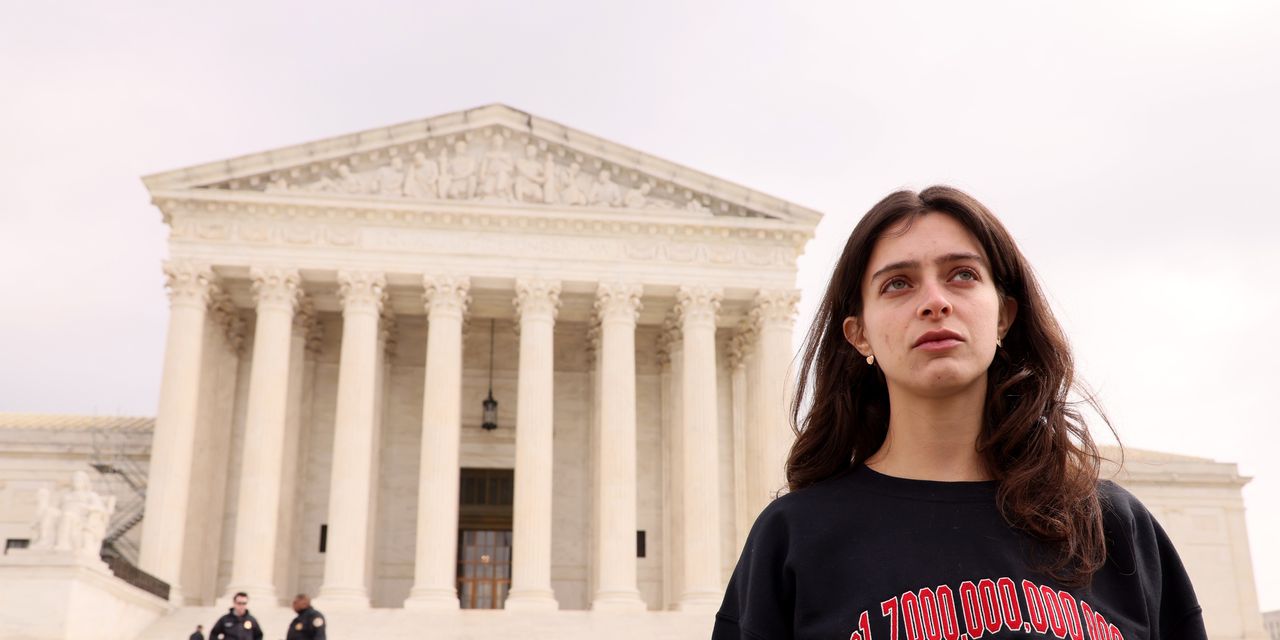Student loan payments are poised to resume this fall without smaller balances now that the U.S. Supreme Court has blocked President Joe Biden’s loan cancellation plan.
The Biden administration’s loan forgiveness initiative would have canceled up to $10,000 of debt for eligible borrowers, and in some cases up to $20,000.
But the Supreme Court’s conservative majority ruled on Friday that the executive branch overstepped its authority by trying to wipe out billions in student loan debt on its own.
“Six States sued, arguing that the HEROES Act does not authorize the loan cancellation plan. We agree,” Chief Judge John Roberts said, writing for the 6-3 majority.
Now it’s time for more than 40 million borrowers with federal student loans to figure out their next move. They are staring at more than $1.6 trillion in student loan debt. Add on private student loans, and the number climbs to $1.7 trillion.
Federal student loan payments have been on hold since March 2020.
Approximately 26 million people had either applied for loan forgiveness or were already eligible for the relief as of late last year, the White House said.
Here’s what to know.
When do student-loan payments restart?
In October, according to the Department of Education. Expect more specifics soon on those payments. “We will notify borrowers well before payments restart,” the department said.
While payments start coming in October, interest starts accumulating on the loans in September. Loan balances have not been accumulating interest since the payment pause started in March 2020, during the pandemic’s early days.
“We will also be in direct touch with borrowers and ramping up our communications with servicers well before repayment resumes to ensure borrowers and their families are receiving accurate and timely information about the return to repayment,” an Education Department spokesperson said.
There’s a range of estimates on how much student-loan borrowers typically pay each month on their loans.
According to Bank of America data, $180 was the median monthly student loan payment as of January 2020. Federal Reserve research before the pause said the average monthly payment was $393, while the median payment was $222.
Can I lower my payments?
Possibly yes, with a range of income-driven repayment plans through the Education Department. These plans are supposed to make repaying loans more affordable by letting borrowers modify their monthly payments based on their income.
While these plans already exist, the department is reworking them. As a result, more monthly income will be shielded from the calculations on what a person could repay for student loans each month, meaning payments will become more affordable. While the revised plans are not in effect yet, the existing plans are up and running.
Many people will likely struggle to fit a student loan bill back into their budget — the question is how far that financial hardship will go. Student loan payments would be hitting at a time when car loan and credit card delinquencies are already rising from their pandemic lows, according to the Federal Reserve Bank of New York.
Part of the Biden administration’s Supreme Court arguments pointed to the possible economic consequences of resuming student-loan payments without canceling some of the debt.
Without cancellation, there will be a “surge” of loan defaults and delinquencies once payments resume, Solicitor General Elizabeth Prelogar told the justices during oral arguments earlier this year.
Analysts at Bank of America agree more delinquencies are coming once student loan payments resume.
What if I miss my first payment?
In the juggle of which debts have to get paid first, a student loan bill might fall behind other monthly debts like a mortgage or a credit card bill.
Anywhere from roughly one-third to three-quarters of borrowers could miss their first student-loan bill when payments resume, according to projections from the credit score company VantageScore.
A missed first payment might eventually lead to an average 49- to 82-point reduction in a credit score ranging from 350 to 850, VantageScore researchers said.
That sounds worrisome, but it’s likely that any credit score dings will not come quick.
Before the payment pause, loan servicers waited for a borrower to miss three straight payments before they reported it to the credit reporting bureaus, Scott Buchanan, executive director of the Student Loan Servicing Alliance, previously said.
Brace for potentially long call hold times, curtailed hours and loan servicer glitches, borrower advocates say. It stems back to Congressional cuts on the funding for vendor contracts that handle the day-to-day details of student loan repayments.
Read the full article here




